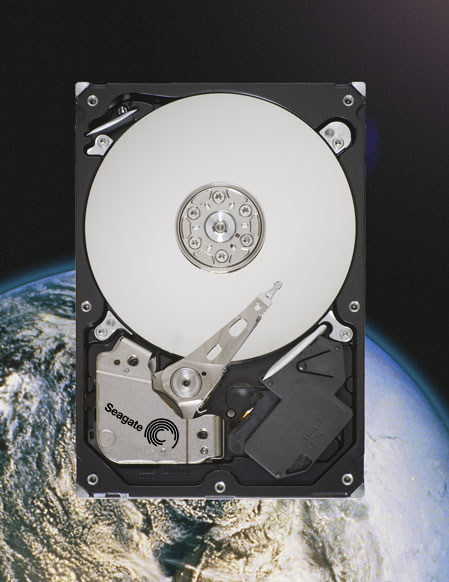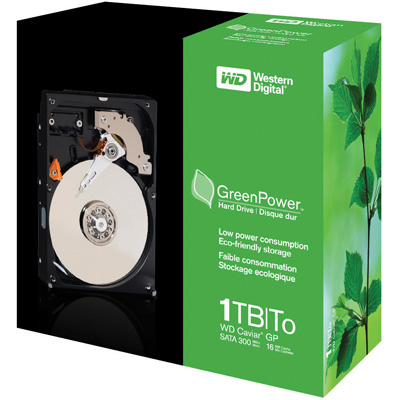Seagate and Western Digital 1TB Drives: Improved and Green
by Dave Robinet on November 26, 2007 7:00 AM EST- Posted in
- Storage
Introduction
When one manufacturer has a breakthrough in hard drive capacity, the other manufacturers rush to make sure their product line contains at least one entry at the new capacity level. However, it can sometimes take a while for actual product to arrive after these announcements, so it can be difficult to buy the particular drive that a consumer wants. Fortunately, the distribution channels have begun to fill with 1TB drives over the last several months, and consumers are now able to buy these massive hard drives with relative ease. In our head-to-head comparison today, we pit Seagate's 1TB Barracuda 7200.11 ES.2 against Western Digital's 1TB Caviar GP, along with updated results from the Hitachi 1TB drive that kicked off the "Era of Tera".
The Combatants
After Hitachi, Seagate was the first of our competitors out of the gate with its 1TB drive announcements, listing several different incarnations of its largest-capacity drive. Seagate positions their Barracuda 7200.11 as a desktop-class drive.

Seagate leverages its industry-leading five-year warranty and PMR recording technology in their mainstream 7200.11 desktop class drive. Anyone familiar with Seagate's drive naming conventions will recognize that this drive is the eleventh generation of their 7200RPM mainstream drives, marking over 15 years that they have been producing drives at that spindle speed. We were surprised once again at the launch of this new class of drive, as Seagate announced the 7200.10 series just over a year ago. The major enhancement in the 7200.11 product series over the 7200.10 is a simple increase in areal density. The platter size increases from 188GB on the 7200.10 series to 250GB on the 7200.11 product. This increase in density is the primary reason for the claim of this drive being "second generation PMR recording technology". The other major change is an increase from 16MB cache to 32MB cache on the 1TB drive. We will look to find out what performance benefits, if any, come with this "second generation" technology.

Western Digital followed Seagate's lead in introducing their 1TB Caviar GP in July of 2007, though their approach to the technology differs considerably. Where the Seagate drive focuses on reliability and trading on their established name, the Western Digital Caviar GP seeks to set itself apart with its low power consumption. This "green" approach - dubbed "environmentally responsible storage" in their product literature - attempts to portray the GP line as environmentally friendly due to a low power consumption figure. While we can all appreciate lower power requirements in our computing components, it remains an open question if users are willing to accept any performance trade-offs to get there. Our main question today is if Western Digital's focus on being "green" comes at the cost of performance, and how does the new Seagate 7200.11 compare to the 7200.10 series. Let us look at the specifications to see the numbers behind the headlines.










31 Comments
View All Comments
darshahlu - Monday, November 26, 2007 - link
One thing I would have liked to see in the article is a RAID test. Specifically, I wonder whether or not the WD drive with its variable rotational speed will have problems in RAID configurations.In my experience with the WD drives, the answer to this question is yes. I have two of the WD Terabyte drives in a RAID MIRROR setup. The issue I noticed is that while copying data onto the mirror from multiple sources, some data becomes corrupt. I contacted WD support about the problem and am waiting to hear back from them. Perhaps it is true that these WD drives simply do not work well in a RAID setup.
Has anyone else experienced problems with the WD drives in RAID?
Darshan
darshahlu - Thursday, December 6, 2007 - link
I contacted WD about RAID support. Here is the response:Response (Jeremy H.) 12/06/2007 05:59 PM
Dear Darshan,
Thank you for contacting Western Digital Customer Service and Support.
The WD10EACS is a desktop drive. WD desktop drives do not work properly when used in a RAID array. I recommend you exchange your WD10EACS drives for the RAID model, WD1000FYPS.
Answer Title: What is the difference between Desktop edition and RAID (Enterprise) edition hard drives?
Answer Link: http://wdc.custhelp.com/cgi-bin/wdc.cfg/php/enduse...">http://wdc.custhelp.com/cgi-bin/wdc.cfg...?p_faqid...
Answer Title: Specifications for the Western Digital RAID edition Serial ATA hard drives.
Answer Link: http://wdc.custhelp.com/cgi-bin/wdc.cfg/php/enduse...">http://wdc.custhelp.com/cgi-bin/wdc.cfg...?p_faqid...
Sincerely,
Jeremy H.
Western Digital Service and Support
http://support.wdc.com">http://support.wdc.com
Zak - Monday, November 26, 2007 - link
I was hoping they'd introduce ACS (Actual Capacity Specification) with the 1TB drives so when I look in My Computer it would actually say 1 TB under Total Size instead of 930 GB. Uncool :rolleyes:Z.
JarredWalton - Monday, November 26, 2007 - link
SI has settled on TB for 1 trillion for a long time. If you want 2^40 bytes, you'll need TiB (tebibyte). While computers have been using Kilo, Mega, Giga, Tera for a long time, the fact is that those were originally designated as 1000, 1000000, 1 billion, 1 trillion, etc. before computers began using the abbreviations. Computer scientists were lazy (as usual - I can say that because I studied CS) and simply used Kilo for 1024 because it was "close enough".As far as I'm concerned, "ACS" has been in use for a long time; now we just need to get operating systems and users to understand the correct meaning of SI prefixes. :)
Chadder007 - Monday, November 26, 2007 - link
What...no check on wattage usage on the drives? If its a "green" drive id like to know how much power its actually saving.nowayout99 - Monday, November 26, 2007 - link
Ditto. I was expecting to see some sort of power draw comparison, afterall the one drive is marketed as being "green."Instead, we're asked to take their word for it.
drebo - Monday, November 26, 2007 - link
Why is it that almost every single article Anandtech puts out has a conclusion that contradicts their own test results?Seriously. If the two drives are so different and so suited for different purposes, why are you even comparing them? If it's just to say that the WD drive excells at being green and the Seagate drive sucks at performance, why even bother with an article?
You cannot judge the drives solely on the merits of the competition while ignoring what the drive is good at.
This right here: "the redeeming feature of the Seagate drive is only that it turns in better results than the Western Digital drive". That's a no-brainer, and anyone could have guessed that by looking at the manufacturer specs. More to the point: wasn't that the goal of the article--to find out which of the two performed better? So, why, in your conclusion, do you completely ignore the fact that the Seagate drive is clearly the better performer?
You judge the Seagate drive for not being quiet, for running hot, for having bad performance, yet you completely ignore the fact that in your little "head-to-head" comparison, it is the victor in terms of performance. By that same token, you praise the Western Digital drive for being quient, for running cool, and you completely ignore the fact that it performed worse than any other drive tested.
The bias on this site is palpable. So much for honest reviews.
yuchai - Monday, November 26, 2007 - link
Do you actually make a HD purchase decision solely based on performance?I actually liked the conclusion. Sure, the WD is slower in almost everything. But if you look at the real life benchmarks it's only about 5% in all apps except WinRAR. Is this difference high enough to offset the savings in price and power consumption? I think this is the type of question that the consumer should be asking, and the conclusion does a good job at doing just that.
Anyway, if you do not like the conclusion, you can easily look at the facts and benchmarks only and make your own call. Ultimately, AT can only give information and recommendations. The decision maker is still you.
JEDIYoda - Monday, November 26, 2007 - link
Exactly what gamer in their right mind is going to be using that 1T for gaming anyways??Things that make you go hmmm....
JarredWalton - Monday, November 26, 2007 - link
This isn't just a comparison of Seagate to Western Digital, obviously. That's why there are several other hard drives listed in the benchmarks. The conclusion for the Seagate fits with the benchmarks: it is slower than (or at best equal to) the Hitachi 1TB drive in every single test. The only thing it has going for it is a five-year warranty, which doesn't count for much in my book. Sure, you can get a replacement drive for an extra two years, but until manufacturers start providing data recovery as part of the warranty I just don't think it's a big deal. I have dozens of hard drives from all the major manufacturers; granted, I'm not stressing every single drive 24/7, but drive failures are uncommon - whether in the first three years or at 4-5 years.WD has lower power (meh - 4W is *nothing* when it comes to power!), but it also has a much lower price. Seagate has a price that is $5 cheaper than Hitachi (at Newegg - though I admit I'm not sure what the difference is between the four Hitachi 1TB drives that show up). The "enterprise" version is also $25 more than most expensive Hitachi - $55 more than the cheapest 1TB Hitachi. Given the better performance (Seagate has low write performance) and essentially equal price, we'd recommend the Hitachi over the Seagate.